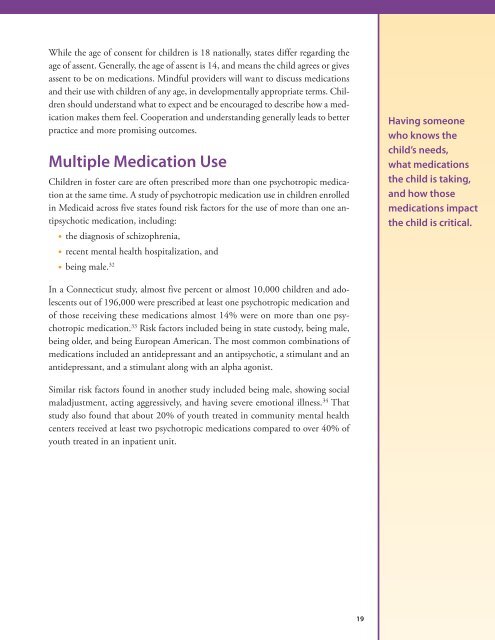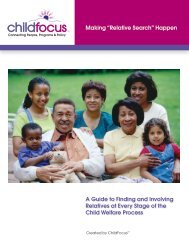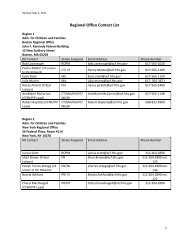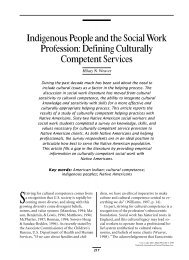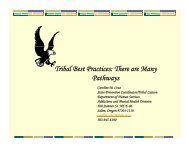Sherilyn, age 17Sherilyn lived <strong>in</strong> foster care between the ages of 5 <strong>and</strong> 9, then was returned to her mother’scare. When she was 11, her mother had her hospitalized for extreme behavioral outbursts,aggression, runn<strong>in</strong>g away, impulsive behavior, truancy, <strong>and</strong> gett<strong>in</strong>g <strong>in</strong> trouble with thelaw for steal<strong>in</strong>g <strong>and</strong> loiter<strong>in</strong>g. These behaviors cont<strong>in</strong>ued <strong>in</strong> the hospital <strong>and</strong> Sherilynwas eventually diagnosed with bipolar disorder.Sherilyn was placed <strong>in</strong> foster care aga<strong>in</strong>, <strong>and</strong> over the next three years she was placedon various <strong>and</strong> multiple medications <strong>in</strong>clud<strong>in</strong>g lithium, amphetam<strong>in</strong>es, buspirone, clozap<strong>in</strong>e,SSRIs, lorazepam, <strong>and</strong> resperidone. She often had some <strong>in</strong>itial reprieve from her symptoms,but did not respond well to any of the medications. Her behaviors worsened, she began us<strong>in</strong>gdrugs <strong>and</strong> alcohol, ran away, <strong>and</strong> began sexually act<strong>in</strong>g out.At 15, she entered treatment where she was taken off all her medications, kept safe <strong>and</strong>conta<strong>in</strong>ed, <strong>and</strong> provided a new set of skills to manage herself <strong>and</strong> her life (dialectical behavioraltherapy). Sherilyn f<strong>in</strong>ally felt cared for <strong>and</strong> safe enough to disclose to staff the ongo<strong>in</strong>g sexualabuse she had experienced by her mother’s boyfriend, who had raped her repeatedly <strong>and</strong>threatened her life <strong>and</strong> her mother’s. Once she disclosed the abuse to the staff, <strong>and</strong> later hermother, her aggression stopped, she no longer had outbursts, <strong>and</strong> although she still struggledsocially she was work<strong>in</strong>g through th<strong>in</strong>gs <strong>and</strong> was medication free.Sherilyn, now 17, is complet<strong>in</strong>g high school, work<strong>in</strong>g <strong>in</strong> a local grocery store, <strong>and</strong>experienc<strong>in</strong>g healthy relationships with her foster parents.Consent to Use of <strong>Psychotropic</strong> <strong>Medication</strong>sAny child placed on medication needs a caregiver’s consent. For children <strong>in</strong> foster care, whohas the authority to consent to the medication is a grey area. In some states, biological parentsmust consent. In others, it is the state or children’s adm<strong>in</strong>istration, the foster parentcar<strong>in</strong>g for the child, the court, or state designated panels or overseers. 29 For children placed<strong>in</strong> a group home, residential treatment center, or <strong>in</strong>patient psychiatric sett<strong>in</strong>g, the physiciansor staff may have consent to treat, which can <strong>in</strong>clude consent to medicate.Conflict is common between <strong>in</strong>terested parties; biological parents may disagree with fosterparents on whether a child should be medicated. Hav<strong>in</strong>g someone who knows thechild’s needs, what medications the child is tak<strong>in</strong>g, <strong>and</strong> how those medications impactthe child is critical. In Ill<strong>in</strong>ois, where a Department of Guardian <strong>and</strong> Advocacy was establishedto oversee medication use by foster youth, reports <strong>in</strong>dicate that mood disordermedications were prescribed to 240 children <strong>in</strong> foster care without state consent. 30 InFlorida, follow<strong>in</strong>g the suicide of a seven-year-old child <strong>in</strong> foster care who had been prescribedthree different psychotropic medications, it was discovered over 3,000 children <strong>in</strong>foster care were found to be on medications without legal consent. 3118 <strong>Psychotropic</strong> <strong>Medication</strong> <strong>and</strong> <strong>Children</strong> <strong>in</strong> <strong>Foster</strong> <strong>Care</strong>
While the age of consent for children is 18 nationally, states differ regard<strong>in</strong>g theage of assent. Generally, the age of assent is 14, <strong>and</strong> means the child agrees or givesassent to be on medications. M<strong>in</strong>dful providers will want to discuss medications<strong>and</strong> their use with children of any age, <strong>in</strong> developmentally appropriate terms. <strong>Children</strong>should underst<strong>and</strong> what to expect <strong>and</strong> be encouraged to describe how a medicationmakes them feel. Cooperation <strong>and</strong> underst<strong>and</strong><strong>in</strong>g generally leads to betterpractice <strong>and</strong> more promis<strong>in</strong>g outcomes.Multiple <strong>Medication</strong> Use<strong>Children</strong> <strong>in</strong> foster care are often prescribed more than one psychotropic medicationat the same time. A study of psychotropic medication use <strong>in</strong> children enrolled<strong>in</strong> Medicaid across five states found risk factors for the use of more than one antipsychoticmedication, <strong>in</strong>clud<strong>in</strong>g:• the diagnosis of schizophrenia,• recent mental health hospitalization, <strong>and</strong>• be<strong>in</strong>g male. 32Hav<strong>in</strong>g someonewho knows thechild’s needs,what medicationsthe child is tak<strong>in</strong>g,<strong>and</strong> how thosemedications impactthe child is critical.In a Connecticut study, almost five percent or almost 10,000 children <strong>and</strong> adolescentsout of 196,000 were prescribed at least one psychotropic medication <strong>and</strong>of those receiv<strong>in</strong>g these medications almost 14% were on more than one psychotropicmedication. 33 Risk factors <strong>in</strong>cluded be<strong>in</strong>g <strong>in</strong> state custody, be<strong>in</strong>g male,be<strong>in</strong>g older, <strong>and</strong> be<strong>in</strong>g European <strong>American</strong>. The most common comb<strong>in</strong>ations ofmedications <strong>in</strong>cluded an antidepressant <strong>and</strong> an antipsychotic, a stimulant <strong>and</strong> anantidepressant, <strong>and</strong> a stimulant along with an alpha agonist.Similar risk factors found <strong>in</strong> another study <strong>in</strong>cluded be<strong>in</strong>g male, show<strong>in</strong>g socialmaladjustment, act<strong>in</strong>g aggressively, <strong>and</strong> hav<strong>in</strong>g severe emotional illness. 34 Thatstudy also found that about 20% of youth treated <strong>in</strong> community mental healthcenters received at least two psychotropic medications compared to over 40% ofyouth treated <strong>in</strong> an <strong>in</strong>patient unit.19


